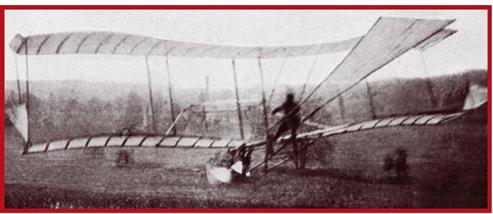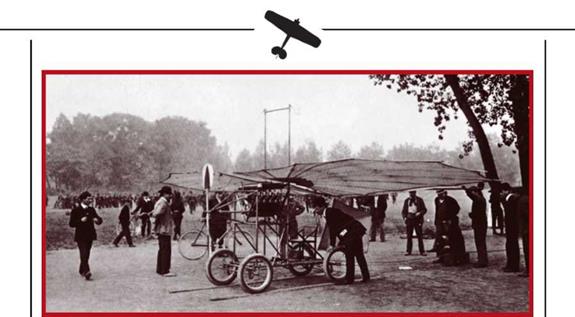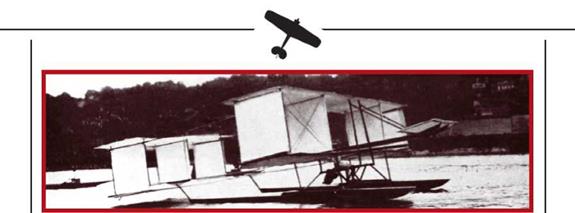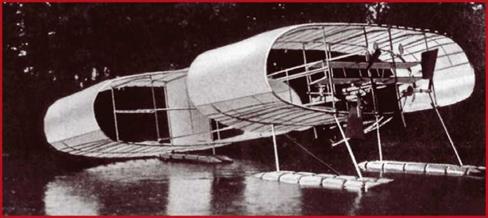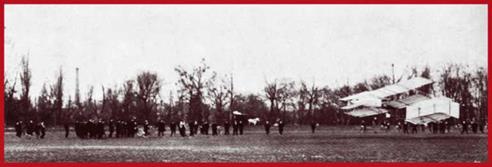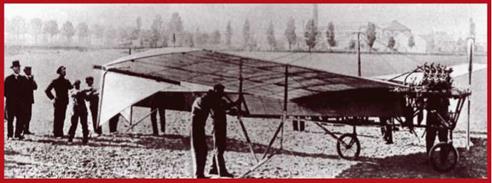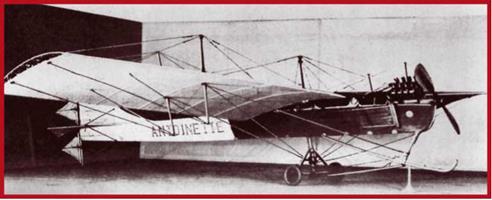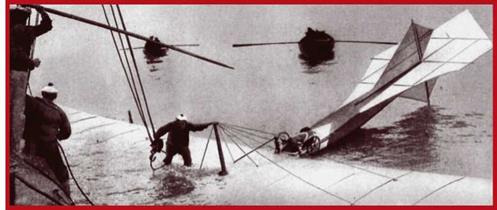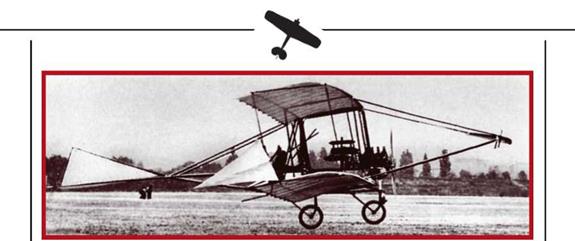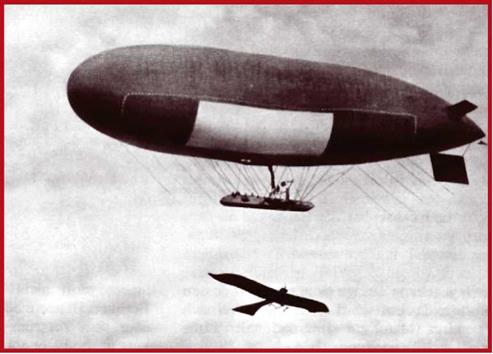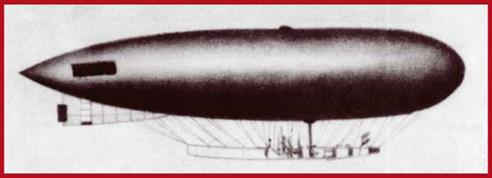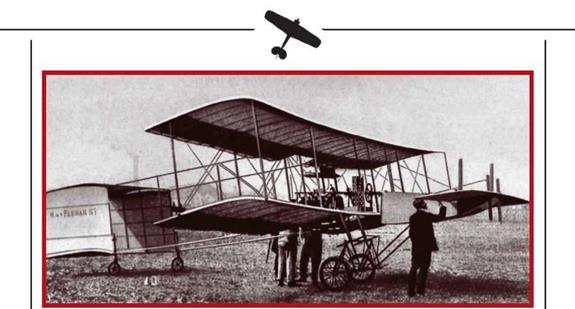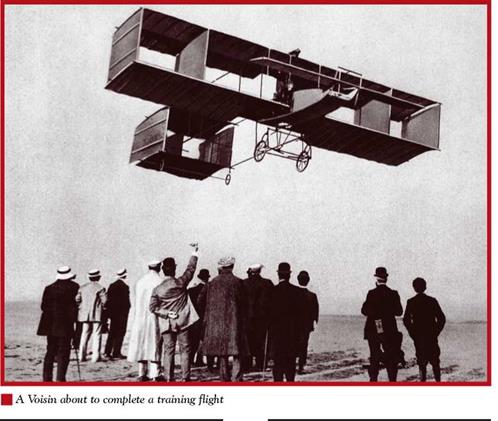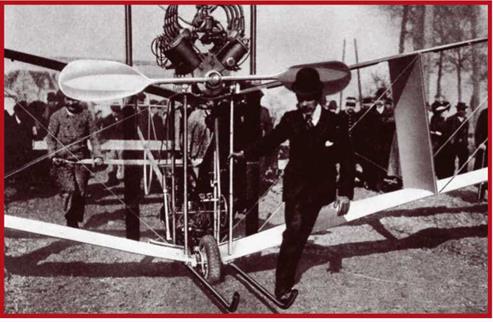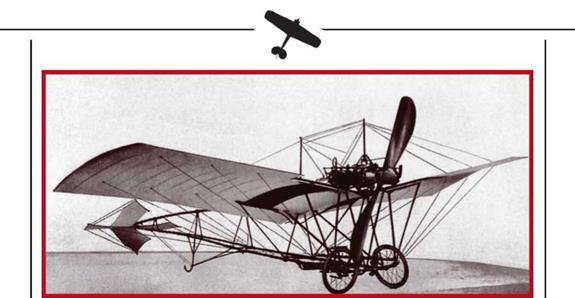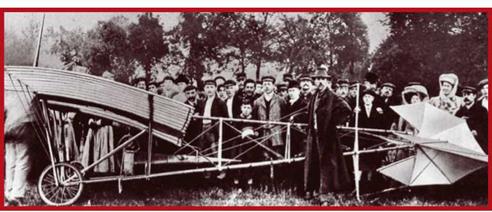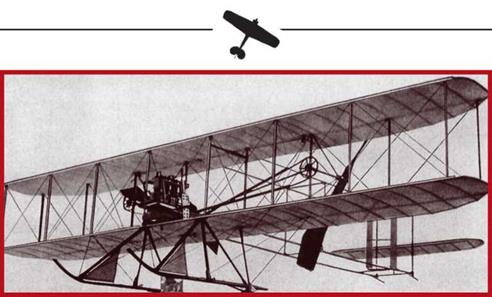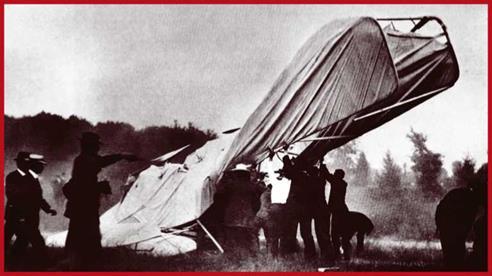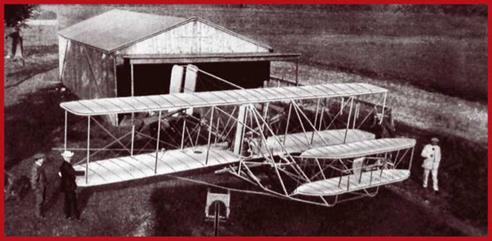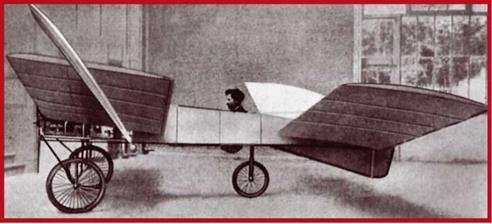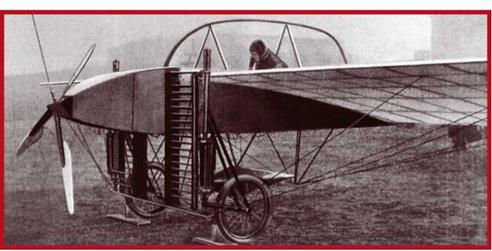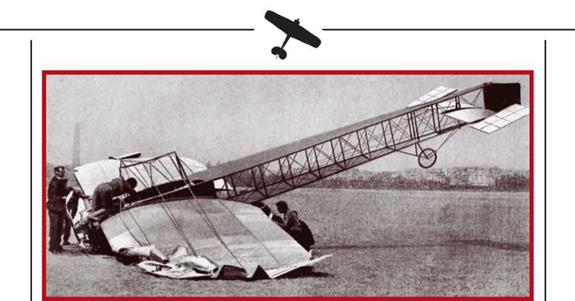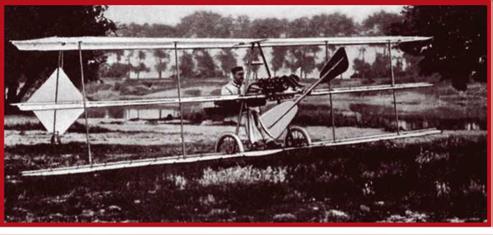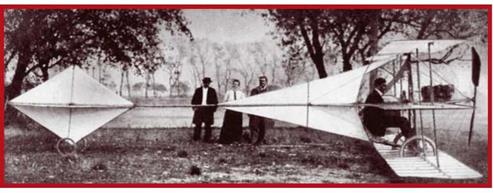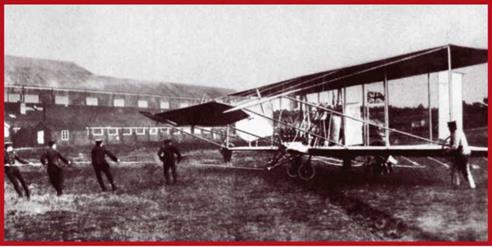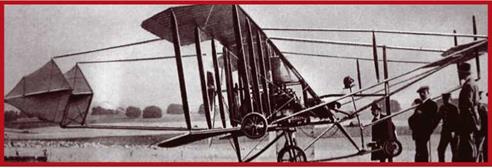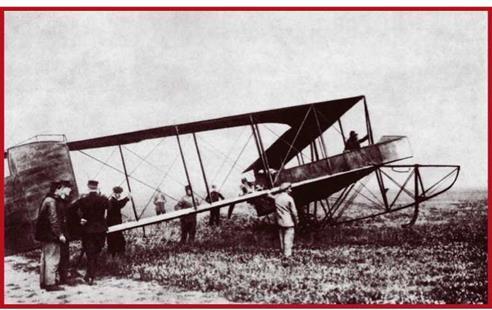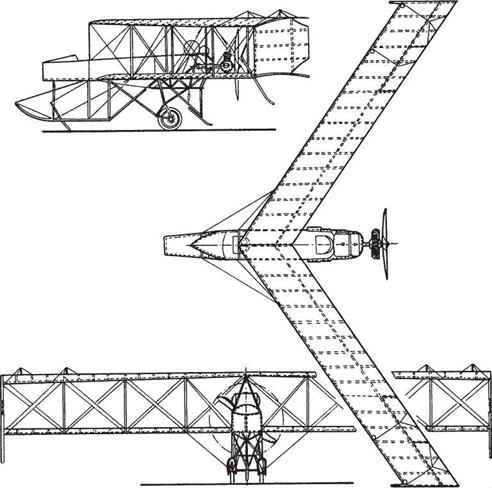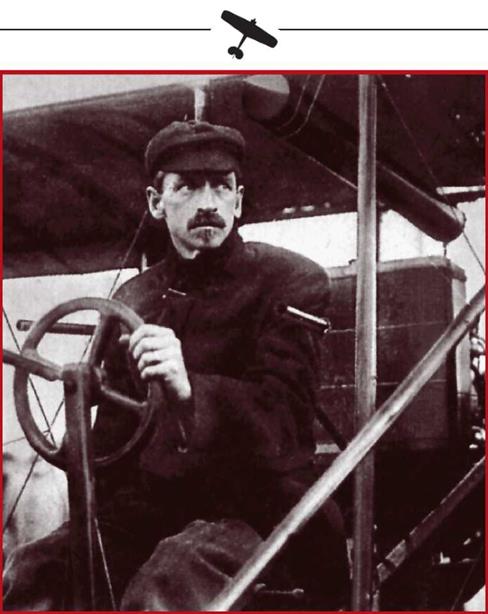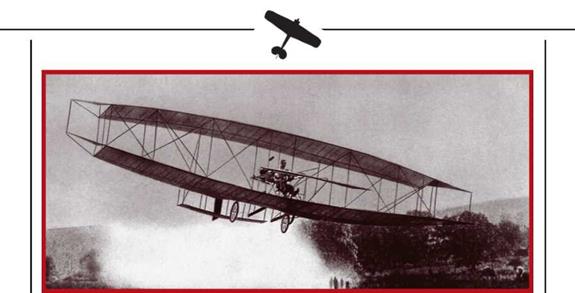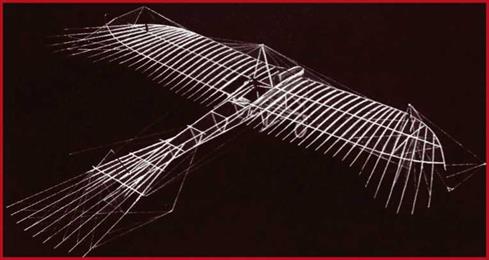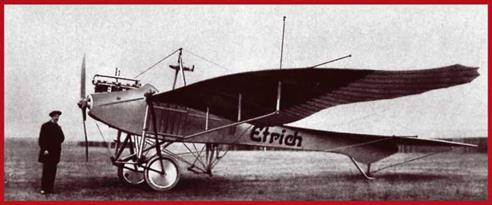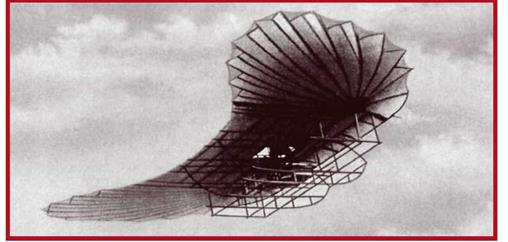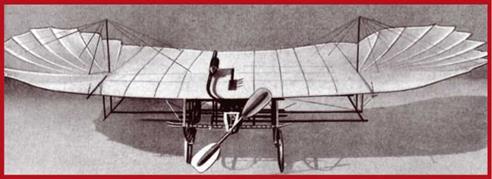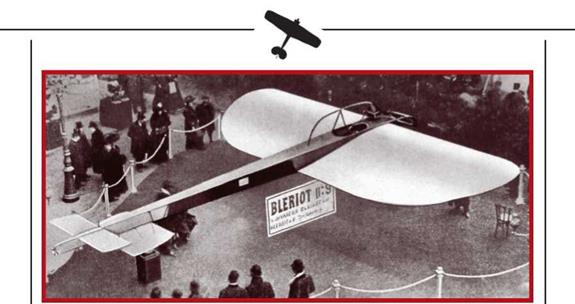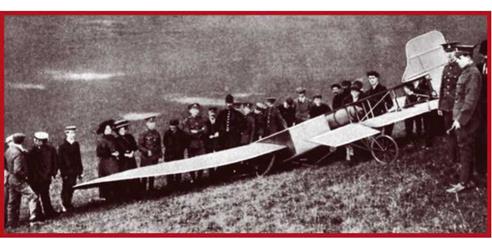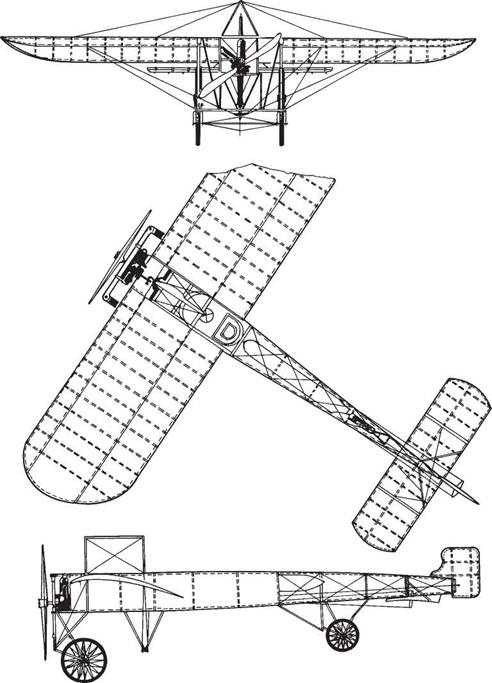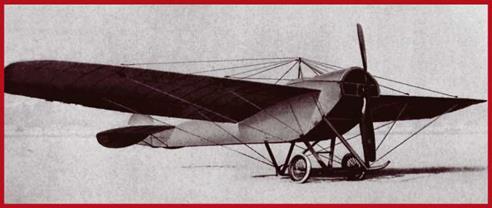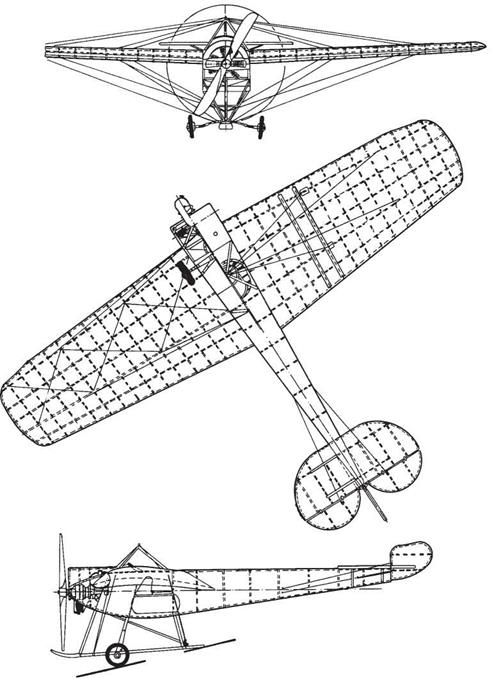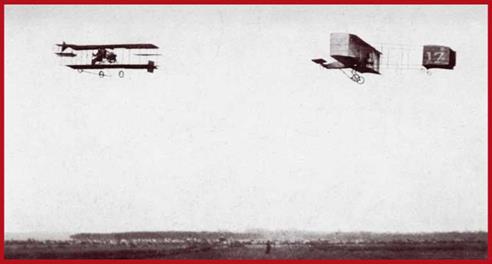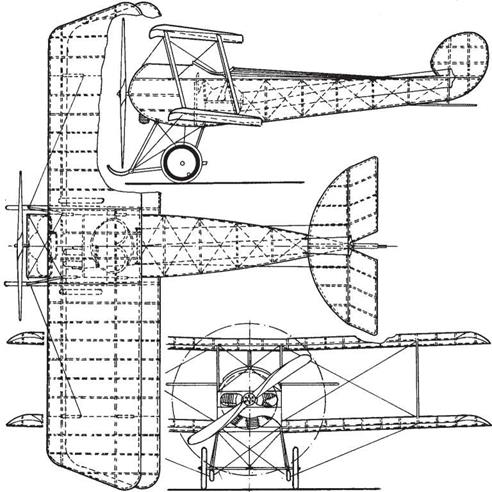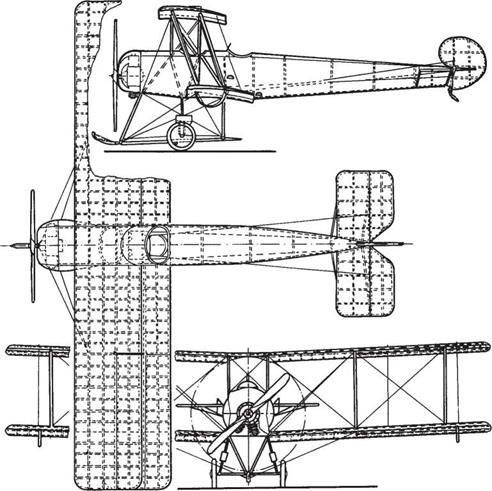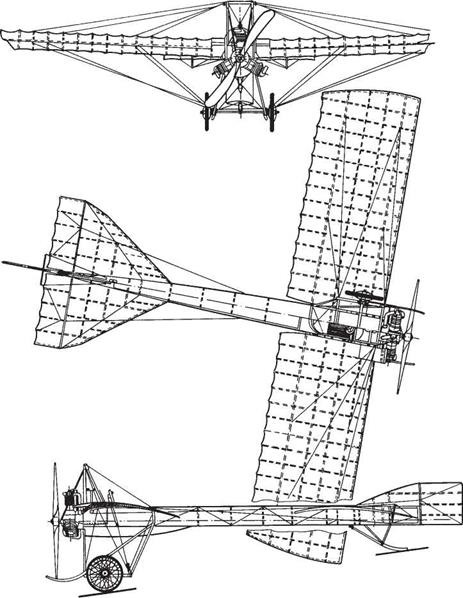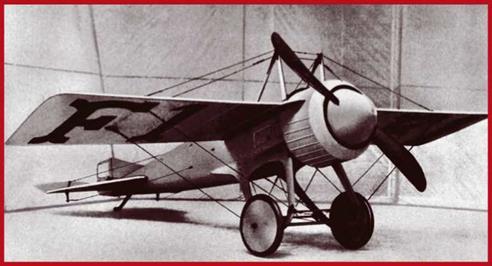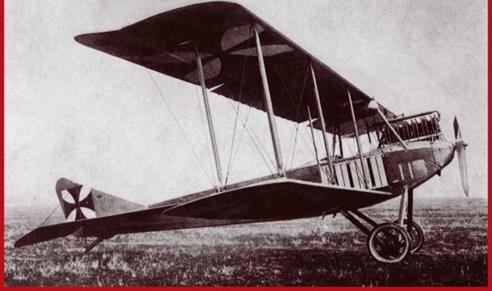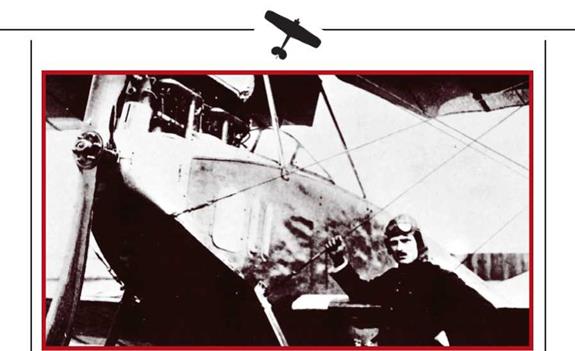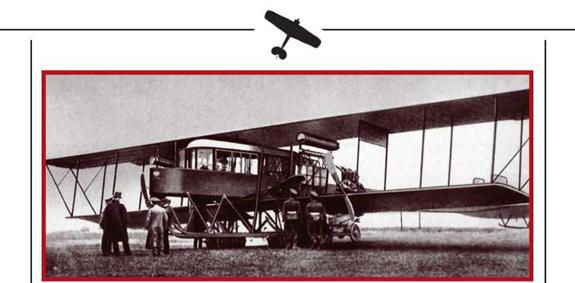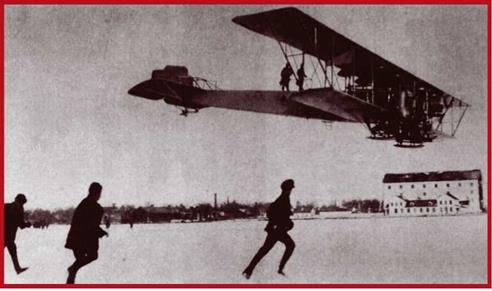TORMY PROGRESS
![]()

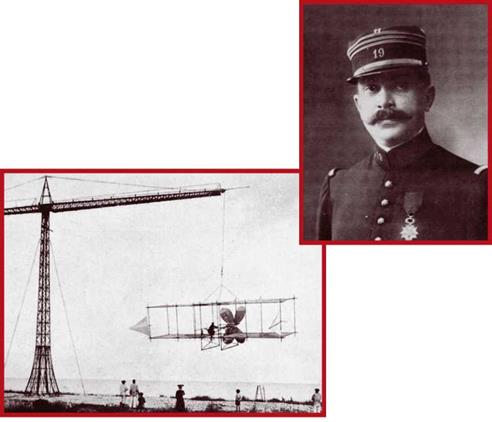 Even the scant attention given to the Wright brothers’ glider trials between 1900 and 1902 stimulated French aeronautics students’ desire to build real aeroplanes. After Lilienthal’s death, European progress in heavier-than-air flying apparatus had come to a standstill. French artillery officer Capt Ferdinand Ferber made the first effort to a resumption. In early 1902, Octave Chanute sent him a copy of the paper on gliding delivered by Orville Wright the previous September. Ferber decided to make a glider similar to that of the Americans, but without the roll control system. He used bamboo and normal timber, and completed the job in 1903. The glider was intended to be powered, and Ferber acquired a 6hp Bouchet internal combustion engine for the purpose, marrying it to two puller propellers. The aeroplane was tested later the same year, being put through its paces while suspended from the gib of an 18 metre high stand. This showed up the engine’s insufficient power: it had to sustain a 235kg machine in flight.
Even the scant attention given to the Wright brothers’ glider trials between 1900 and 1902 stimulated French aeronautics students’ desire to build real aeroplanes. After Lilienthal’s death, European progress in heavier-than-air flying apparatus had come to a standstill. French artillery officer Capt Ferdinand Ferber made the first effort to a resumption. In early 1902, Octave Chanute sent him a copy of the paper on gliding delivered by Orville Wright the previous September. Ferber decided to make a glider similar to that of the Americans, but without the roll control system. He used bamboo and normal timber, and completed the job in 1903. The glider was intended to be powered, and Ferber acquired a 6hp Bouchet internal combustion engine for the purpose, marrying it to two puller propellers. The aeroplane was tested later the same year, being put through its paces while suspended from the gib of an 18 metre high stand. This showed up the engine’s insufficient power: it had to sustain a 235kg machine in flight.
In 1904, Ferber improved the aeroplane, fitting a tailplane aft of the wing. The wings were given some anhedral in an attempt to improve longitudinal stability. A new and more reliable
|
I Ferber’s attempted free flight in 1905 |
Peugeot engine, again rated at 6hp, was fitted. The puller propeller was between the wing assembly and the forward mounted elevator.
A flight attempt was made on 27 May 1905 when Ferber intentionally cut the holding rope. However, all that the weak engine did was merely reduce the gradient of the precipitous glide. Nevertheless, the puller propeller/biplane aerodynamic configuration was rational, and was to spread far and wide a few years hence.
The enthusiastic gunner went on to build a third aeroplane in 1906. This featured a significantly more powerful Antoinette engine, whose output reached 24hp at 600rpm. Regrettably, the aeroplane was destroyed by a storm on 19 November, a little while before its planned first flight.
When the Wrights stopped flying, aviation advance palpably slowed. Ferber was not the only one to try and acquit the Old World. Transylvanian[5] Traian Vuia, who lived in France, conceived a Flying Automobile. Its road-going progenitor left a strong imprint on the finished article which had four leaf-sprung, pneumatic-strutted and tyred wheels; a steering wheel controlled the rudder. The wing folded for easy transport by road. Control was to be achieved by tilting the wing, and longitudinal trim: by sliding the seat fore and aft. The steel tube and cloth article weighed 192kg, had an erect span of 8.7m and a wing area of 20sq m. The engine, a 24hp Serpols unit, drove a two-bladed puller propeller with a 1.5m diameter.
The Vuia 1 entered testing in March 1906. On 18 March it took off and flew for 12m at a height of a metre. Five months later, this distance was doubled but the landing was a crash. Despite the modest achievements, these hops boosted interest in monoplanes. Vuia’s later improvements to his apparatus, which included modifying the controls, led nowhere: testing in October showed it to be incapable of sustaining level flight.
|
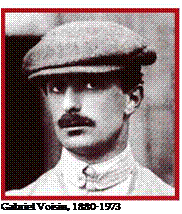
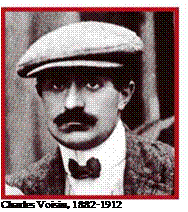 Gabriel Voisin was one of the most famous of pioneer aviators. He was a French mechanic who had designed and built his own gliders. In 1905, he made a float-equipped glider with a strange wing. It took off by being pulled along the Seine by a motor boat, and testing proved that boxing the wing as in a kite resulted in good stability, as well as improving structural strength for a given weight.
Gabriel Voisin was one of the most famous of pioneer aviators. He was a French mechanic who had designed and built his own gliders. In 1905, he made a float-equipped glider with a strange wing. It took off by being pulled along the Seine by a motor boat, and testing proved that boxing the wing as in a kite resulted in good stability, as well as improving structural strength for a given weight.
Using his glider experience, in spring 1906 Voisin built the Bleriot III (thus called because it was ordered by Louis Bleriot, later to be a renowned designer, maker and flyer in his own right). In profile, the wing was ellipsoid. The idea was to box it and give it anhedral for roll stability in one. The rudder was within the wing. The aeroplane was intended to depart and alight from and on water, as the glider had, and it was fitted with two fore and one aft floats. A 24hp engine drove two forward propellers via bicycle chains.
Testing began in May 1906 and soon revealed that the powerplant caused strong wing vibrations at certain regimes. Nevertheless, on 12 September the designer did fly a distance of 42m at a metre above the surface, and an average speed of 57km/h. It turned out that such hops afforded no control whatever. The
|
The float-equipped Voisin glider being towed on the Seine at Paris in 1905 |
|
The Bleriot III, in which the later-famous Bleriot first tried to fly |
|
|
attempt to get rid of vibrations by fitting two engines, each driving its own propeller, ended in failure: the heavier machine could not improve on its earlier parameters.
After a fruitful summer, Gabriel and Charles Voisin formed the world’s first aeroplane making company. Orders piled in, especially after a famous flight by eminent aeronaut Santos-Dumont. The Bazilian had designed the 14-bis aeroplane. A hybrid between the Wrights’ Flyers and Hargrave’s kite, this was a canard biplane with a biplane forward elevator and a pusher propeller. A peculiarity of the design was its pronounced dihedral. The engine was a 24hp Antoinette. The structure was of timber and bamboo. The pilot stood upright in a basket-like container. The rest of the fuselage was of square section, entirely cloth-covered.
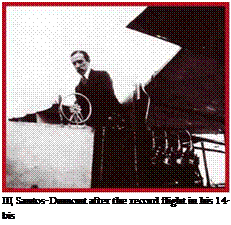 Santos-Dumont began tests in 1906. The Aeroplane was towed behind a dirigible (again designed by himself, hence the bis in the designation). In late August, an attempt was made to fly free, but the contraption failed to get off the ground. Subsequent runups ended in failure. One reason for this was the weak engine, which was changed for a more powerful 50hp Antoinette. The modified aeroplane flew for some 70 to 80m at 3m on 23 October. This was enough for all members of a French Aero Club committee, who witnessed the flight, to admit that Santos – Dumont qualified for the Prix Archdecon, instituted for the first man to fly a distance of not less than 25m.
Santos-Dumont began tests in 1906. The Aeroplane was towed behind a dirigible (again designed by himself, hence the bis in the designation). In late August, an attempt was made to fly free, but the contraption failed to get off the ground. Subsequent runups ended in failure. One reason for this was the weak engine, which was changed for a more powerful 50hp Antoinette. The modified aeroplane flew for some 70 to 80m at 3m on 23 October. This was enough for all members of a French Aero Club committee, who witnessed the flight, to admit that Santos – Dumont qualified for the Prix Archdecon, instituted for the first man to fly a distance of not less than 25m.
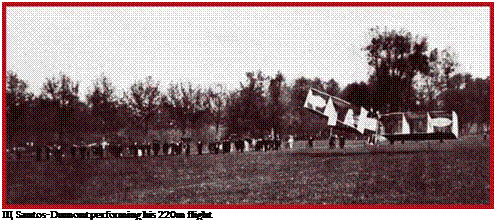 |
On 21 November the designer won a second similar prize, this time for a flight covering not less than 100m. This time he rose to
6m and covering a distance of 220m. Of course, this was not the first powered aeroplane flight, and indeed the 14 bis was only just an aeroplane, being immensely unstable and yawing uncontrollably. The yawing was not cured even after ailerons were installed. Its great many imperfections make it clear that the credit for its flights lies mainly with the excellent engine and well-chosen weather. A crash in early 1907 was the natural end to its career. Nonetheless, the enormous enthusiasm caused by reports of its flights stimulated the efforts of many pioneers, and the acclaim of the public.
One of Voisin’s early clients was French sculptor Leon Delagrange. His Viosin – Delagrange 1 was a motorised version of the Voisin-built floatplane glider. The engine was the proven 50hp Antoinette, and a wheeled undercarriage replaced the floats. The aeroplane had a biplane elevator, with the side members of the tailplane acting as rudders. Span was 10m and wing area, 40sq m. Fitted directly to the engine output shaft, without a reductor, the metal pusher propeller spun at up to 1000rpm.
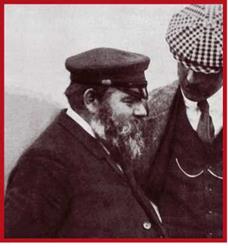 First trials set tor 28 February 1907 resulted in some successful hops. On 30 March Charles Voisin covered a distance of some 80m. Then the wheeled undercarriage was removed and replaced with floats, but when this did not increase flight lengths, the designers reverted to wheels. On 3 November 1907, Leon Delagrange flew a distance of 500m but crashed on landing.
First trials set tor 28 February 1907 resulted in some successful hops. On 30 March Charles Voisin covered a distance of some 80m. Then the wheeled undercarriage was removed and replaced with floats, but when this did not increase flight lengths, the designers reverted to wheels. On 3 November 1907, Leon Delagrange flew a distance of 500m but crashed on landing.
The Antoinette engines which were becoming favourites to inventors of early aeroplanes, were designed by French engineer Leon Levavasseur. Initially intended for light maritime applications, they were later adapted for airborne use. Two major versions were Ш Leon Levavasseur, 1863-1922
|
made: 24hp and 50hp, both extremely compact for the time. In seeking potential European buyers, Levasseur tried to make his own aeroplane. It was to share the name of the engine, which had been named after Levasseur’s employer’s daughter, Mademoiselle Antoinete Gastambid. The Antoinette 1 was to have been a canard monoplane with a pusher propeller, but regrettably the project did not reach conclusion.
In 1908, Levavasseur designed a second monoplane. This had a long fuselage and a rather advanced wing profile, with a great thickness to chord ratio and different upper and lower curvatures. The wing planform was a trapeze with an area of 24sq m and a span of 10.5m. Weight reached 350kg. The more powerful 50hp engine was chosen for the aeroplane, but even this was insufficient for a proper flight, trials resulting in a few hops. This did not out off the designer, but rather, spurred him on. In July 1908 he completed detail work on the Gastambid-Mangen-2 by fitting it with triangular ailerons at the wing tips. On 21 August the new machine flew a circular flight lasting 1m36s. The Gastambid-Mangen-2 was the first manned monoplane to fly.
The Antoinette 4 appeared in 1908. Similar to Levasseur’s early designs, this had a trapezoid wing, a puller propeller, and a long thin fuselage. All-up weight reached 460kg. The engine was the same as in the previous design. To cut drag, the cloth covering the wing’s upper surface was varnished to a gleam. Wing and body structural elements were made of metal. The undercarriage was of the single pivot type, with pneumatic damping. The wing undersides had skids, with another skid guarding the propeller from striking the ground in heavy landings.
The aeroplane showed excellent qualities, prompting French pilot Latham to attempt to fly the Channel. On a good July day in 1909, he set off superbly, but shortly before reaching the English coast problems developed and the machine had to land on water. In August the saem year, an Antoinette 4 piloted by Latham flew the distance of 155km in 2h17m at the first international air races in Rheims. The aeroplane was widely exported in the years before the Great War.
|
The builders of the Gastambid-Mangen 2 checking its undercarriage before a flight attempt |
A year earier, in July 1908, Ferber completed his last aeroplane, the Ferber 9. Built by Antoinette, it was a puller propeller biplane and a forward positioned elevator. Span was 10.5m, wing area was 30sq m, weight was 400kg, and the engine was a 50hp Antoinette. Trials began in the summer and were successful. The aeroplane was exceptionally stable, covering a distance of 500m in September. This was Ferber’s first and last aeroplane to make it into the air. The designer was to die in an air crash in autumn 1909.
As mentioned above, Maj Parcival was a successful designer of non-rigid airships. On leaving the army in 1907, he organised airship manufacture for civil and military use. Between 1909 and 1913, his company built 18 examples, some of which went on to transport passengers, while others were bought by the German, Austro-Hungarian, British, Italian, Japanese, Russian, and Turkish armies.
The British became worried by the interest the German military lavished on the LZ-4. Disquiet became pronounced with the news that after the craft’s widely publi-
|
An Antoinette 7 before its second Channel flight attempt on 27 July 1909 … |
|
… and after it |

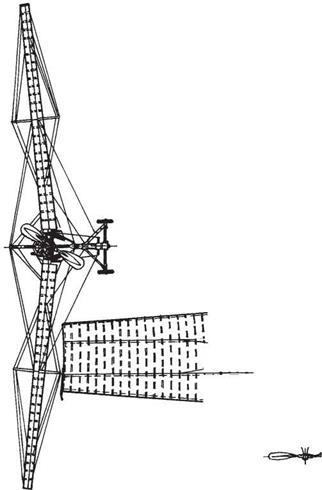
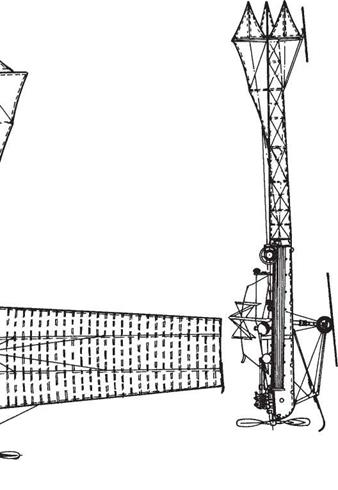
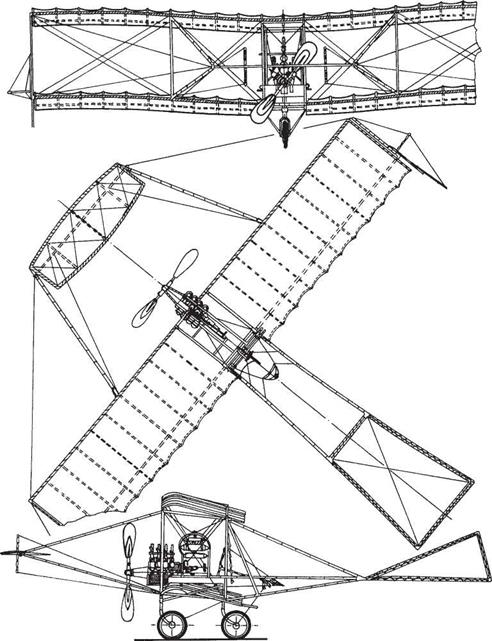
|
|
The Ferber 9, also known as the Antoinette 3 |
cised demise, patriotically minded Germans had subscribed money for yet more airships. At a time of intense Anglo-German naval rivalry, it became clear that Germany, possessor of Europe’s (and possibly the World’s) most powerful land army, was now aiming for naval and aerial supremacy.
How was this challenge to be met? The question turned out rather difficult. In 1907 the Army Balloon Factory built a small sausage-shaped airship. Named the Nulli Secundus, its first flight covered the distance between Farnborough and Crystal Pal-
|
A Parcival P IV non-rigid airship |
ace, overflying St Paul’s Cathedral en route. Covering the fifty miles took a little under three and a half hours. In 1908 the vessel was modernised, but the resulting Nulli Secundus II was also rather tardy to have any military significance.
In fact, British hopes of competing with the Germans rested with large rigid airships. This was the class of vessel the Admiralty wanted. The task was assigned to Vickers, Sons and Maxim Ltd (soon to be just Vickers after Sir Hiram Maxim left the board). The company had built Britain’s first submarine. Initial plans included the wide scale use of duralumin, a new German-discovered light alloy, which Vickers also made.
When the project was first presented, head of the Maritime Armaments Department head Capt Bacon was dissatisfied and decided on a course of constant inspections during construction and preparatory work. Thus he personally supervised compliance between what was wanted by the War Office Maritime Design Department and what was being done at Vickers. Bacon was a firm adherent to the ideas of air power and of adapting airships for Navy needs. His findings found favour with the Admiralty which in turn held him responsible for their implementation. Sadly, no sooner had the project started than Bacon resigned as part of a heated argument between Admiral Lord Charles Beresford and First Lord of the Admiralty, Sir John Fisher. Bacon was succeeded by Capt Murray Suiter, another firm adherent of naval aeronautics. Sadly, Suiter knew little about aeronautics. He took the job of Inspecting Captain well aware he had to trust Vickers. The responsibility for failure was thus passed down to Vickers’ maritime design managers who had no aeronautic experience, and no background in the construction of rigid dirigibles or the new special materials used in them.
To construct the vessel, Vickers began building a huge airship hangar near Barrow-in-Furness. This turned out so hugely expensive that it absorbed the entire project’s budget. Suiter turned to the War Office for additional funds. His application led to another round of inconclusive discussions about the number of airships versus aeroplanes on order for the Navy and Army.
When the job was nearing completion, a mathematician consulting Vickers on stresses reported that the numerous departures from initial design specifications meant the airship would lack the requisite strength. Nonetheless, completion went ahead with the added proviso of additional ground tests prior to first sailing.
In late spring 1911, the 137m long Mayfly, as it had been popularly dubbed, was ready to fly. Moored at a purpose built tower, it had overcome strong winds successfully. However, serious defects were discovered in its lifting engines, and it was walked back into its hangar for modifications. The date of 24 September was set for further tests. As the Mayfly was being walked out on that day, its upper parts struck the hangar, sustaining irreparable damage. Fortunately for posterity, photographers managed to document its final appearance shortly before the accident. Navy officers present were unanimous in declaring the airship “more the work of lunatics than anything
|
I Russia’s most competent pre-World War airship was the Al’batros |
else”. An enquiry reached the verdict that structural weakness had lain at the bottom of the events, recommending the cessation of further work. The hundred thousand pounds Sterling spent on the Mayfly project were ultimately written off, the Admiralty redirecting efforts at heavier-than-air apparatus.
Some years after the defeat of the Russo-Japanese War, in early 1909 the Russian Army and Navy bought indigenous and foreign-made airships. By 1912, the Army had ten dirigibles. They were of the semi-rigid class, with a single long gondola for the pay/warload. Largest was the P-7[6], a 70m long Parcival type vessel which had a radio station broadcasting within a 500km radius. By 1914, Russian dirigibles had grown to 15: German, French and British designs, some of them manufactured in Russia. Eleven of them had limited performance, being limited to some 50km/h. Only four genuinely met military specifications. Best among them was the Al’batros,[7] a 10,000cu m design with a ceiling of 2000m, and a 75km/h true cruise speed. Its complement was between eight and twelve men.
The aeronautical situation in France and Italy was similar. Germany was the un – oubted leader in giant airships. Their performance allowed them to perform a great variety of tasks, with operational and strategic reconnaissance assigned as their main use in a future war.
Meanwhile, the performance of heavier-than-air machines was improving by the day. Progress threw up new names fated to become legends in aviation. One such was Henry Farman. Known in France as ‘Henri,’ he was one of the three sons of British journalists working in that country. Fascinated by the achievements of pioneer flyers, he ordered an aeroplane from the Voisins. This was to be the constructors’ first departure from their early aeroplanes’ trademark box-wing biplane construction. The aeroplane had an unusual layout. It was a triplane with a span of 6.3m, an elongated body,
|
The Voisin-built biplane in which Henry Farman made his first successful flight |
|
Henry Farman speaking with a trainee pilot about to fly a Farman |
and a biplane tail. It was fitted with a Renault automobile engine driving a pusher propeller. Elevators and rudder were forward-mounted. No evidence of flights with this strange machine survives. Farman must have been disappointed and began modifying the design. The new version had four ailerons: one on each of the four wingtips. They deflected only downward, but their large area made them effective enough. Wing area was 40sq m with a span of 10m. The engine remained the same, its 50hp rating being sufficient for the 530kg all-up weight.
Initial tests showed adequate flying qualities. On 2 October 1908, Henry Farman set a distance and height record for a French built aeroplane by flying 40km in 44m 31s. On 30 October the same machine performed aviation’s first city-to-city flight when it
|
|
|

departed from Bouis and landed in Rheims (the two are 27km distant). This marked the end of the Voisins’ fruitful period of cooperation with Farman.
The former truned their attention to their ‘Standard Voisin’ which was assembled and towed out in December 1908. This was to be their first series-produced design. Within six months, 16 machines were built for clients which included the Odessa Aero Club in Russia. The original Voisin glider could still be divined in the aeroplane’s appearance. Engines were different, but all drove a pusher propeller. Major materials were timber and cloth, the latter covering only the upper surface of the wing, and the exterior of the ‘stabilisers’ and some parts of the body. Only the undercarriage was of steel for strength. The biplane had the same span and wing area as Farman’s design, and a length of 12m. Maximum recorded speed was 55km/h.
The lack of ailerons (or an other means of roll control) meant the machine was not particularly manoeuvrable. Turns had to be flat, taking a long time and covering a great area. Despite this shortcoming, the aeroplane was among the most popular designs of the next few years. Thanks to its stability, even in strong wind, the Standard Voisin was preferred for initial pilot training. It saw action as a recce and light bomb-
|
|

|
ing platform in the Tripolitanian, First and Second Balkan, and the initial stages of the Great War.
The crash of the 14 bis did not set that eternal seeker, Santos-Dumont, back. He built the 15 bis, which however inverted on its first take off and was damaged. Santos – Dumont resotred it, but did not fly it any more, directing his efforts at monoplanes.
The 19 was finished in late 1907. The machine was extraordinarily compact and rational looking. Span was barely 5m, and wing area was 11sq m. This was history’s first micro aeroplane. To cut weight, bamboo and cloth had been used almost exclusively. Calculations showed that a 20hp engine would be sufficient to haul the sub – 200kg craft into the air and give it good controllability. Yet the lack of ailerons and the ineffectiveness of the other controls meant a difficult test career.
The aeroplane suffered a failure on its third takeoff attempt. The Brazilian refused to repair it, preferring to devote what means he had to the 20, or the Demoiselle, as the 19’s modified successor was to be called. The structure was strengthened with thin metal piping used instead of bamboo for structural elements. Without practically any change to the craft’s appearance, the control system was changed to allow the pilot to control the aeroplane by shifting his body around, as well as by moving levers. The same 30hp engine type as in the previous version was located between the two wing halves, near the leading edge. Despite being flown successfully and attaining a 90km/h
|
Щ The 15 bis biplane being towed by designer Santos-Dumont; the visibly great dihedral was intended for roll stability |
|
H Santos-Dumont’s Demoiselle looked similar to his 19 and 20 |
speed, the Demoiselle was insufficiently developed. It was to be the eminent Brazilian’s ultimate design.
The appearance of European designers able to attain impressive indicators shook the Wright brothers’ conviction that they would remain unchallenged for a long time. Their patent was threatened: aeroplane making was developing well regardless of their absence. In order to salvage something from their invention, in 1905 they cut the asking price for a French licence by half to 500,000 franks. Flyer III was sold to the US Government for 25,000 dollars. Negotiations started with British and German aviation hopefuls. One of the contracts called on the Wrights to fly demonstrations in an aeroplane similar to the Flyer III, but with two seats, and with pilot and passenger sitting upright. The fuel tank was also increased for greater range and endurance. The new pilot position called for modifications to the controls. The engine, another Wright,
|
Щ Alberto Santos-Dumont surrounded as usual by an adulating crowd |

|
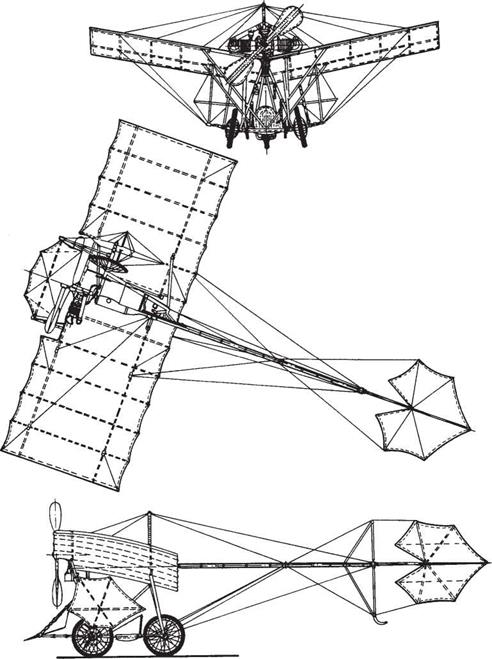
|
|
|
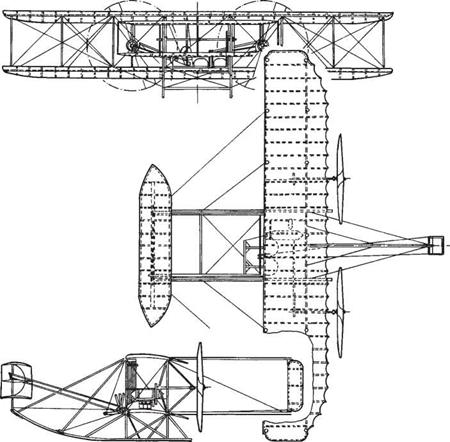
was also new, this time producing 30hp. Length was 8.9m, span was 12.5m, and wing area was 47sq m. There was still no undercarriage, the aeroplane landing on skids.
In May 1908, before departing for Europe the Wrights began testing their new type. History’s first biplane flight with a passenger on board was on 14 May. The passenger was W. Fernas, Wilbur Wright’s assistant, who was in the air for a total of 20 seconds. Soon after, Orville Wright notched up a 3m 40s flight.
The demonstration flights began in August 1908. The brothers parted, Wilbur going to France. In the short time between 8 and 31 August he performed 104 flights lasting a total of 25 hours over the Old World. His last flight, in which he covered 129km in 180 minutes won him a 20,000 frank prize. Meanwhile, Orville flew near Fort Myer, Virginia, demonstrating the second example fo the new design. He made ten flights, four of them lasting over an hour. The last one, on 17 September, ended in a crash. The reason turned out to be a defect in one of the propellers. The pilot was badly hurt, and his passenger, friend and Army engineer Thomas Selfridge, died.
The European aviation community was impressed with the manoeuvrability of the Wright brothers’ aeroplane. They witnessed turns with banks of up to 25 degrees, executed not just with a rudder (as in contemporaneous European types), but also with ailerons and wing camber control which moreover were not just used for countering the odd involuntary roll.
Another good idea was the use of gearing for the propellers. Thanks to the Wrights’ reductor, they used larger timber propellers which worked more efficiently. European designs had more primitive metal props with direct drives. As a result of its superiority,
|
I Moments after Orville Wright’s crash which killed passenger Thomas Selfridge |
the Wright A flew considerably better with almost half the installed power of Voisins, Levasseurs, and Santos-Dumonts.
The Europeans reacted swiftly: ailerons became a compulsory feature of subsequent designs, gearing was fitted to reduce propeller speeds, and the latter were now made of timber and grew in size. By early 1909, newly-designed French aeroplanes could match or outdo the Wright A. Some were more stable and controllable, while others had lighter and more powerful engines and were more autonomous due to their wheeled undercarriages.
|
I Wrights during detnonstrations in France |
|
Щ A Wright in front of a hangar |
|
|
The Wrights’ most serious competitor was one of aviation’s legends: Frenchman Louis Bleriot. His road to success and fame was hard. After a short and not altogether satisfactory spell of working with Gabriel Voisin, Bleriot modified his private Voisin and renamed it the Bleriot IV. Fitted with floats for testing from water, this failed to get airborne, as it also failed when using a wheeled undercarriage: the engine was too weak. But the designer was also clear that the overall concept needed changing. The Bleriot V of April 1905 was the first of a series of trademark monoplanes. It was a canard with a span of 7.8m and a wing area of 13sq m. The engine was a 24hp Antoinette driving a pusher propeller in the aft fuselage. Gross weight was just 236kg thanks to, among other things, the machine’s paper covering. It was this aeroplane that rewarded its creator with his first hops of a few metres each. The last of these ended dramatically. Being inex-
|
| The Bleriot V after its crash-landing |
|
Louis Bleriot’s tandem monoplane |
————————————————- —>—————————————————————————————————-
perienced in the use of the elevator, Bleriot handled it roughly, causing the monoplane to stall, drop its wing and crash. While its maker was unhurt, the aeroplane was so damaged that repairing made no sense.
The next attempt involved seeking the ideal configuration. Bleriot chose a tandem with great dihedral. Spanning just 5.9m, it had a 20sq m wing area. The engine was as before. The control method was changed. The forward wing had elevons at its tips, in addition to which the designer used balancing by sliding his seat fore and aft for pitch control.
The Bleriot VI was tested in July 1907, being flown also by Ferber and Peyret. Distances flown had now grown to over 100m. The designer felt that a yet more powerful engine was needed, and fitted a 60hp Antoinette. The heavy six-cylinder unit affected trim in what was already a rather unstable machine. The anticipated control problems reared their head, a trying first flight ending with a heavy landing; only Bleriot’s cool head avoided a worse outcome. Worse for wear, and with his ungainly creation in even poorer shape, he received an Aero Club prize for covering a distance of 184m.
The next step was the building in November 1907 of the Bleriot VII. This was a clean looking machine some 20 years ahead of its time. The low-wing monoplane with its long and entirely cloth-faired fuselage, forward propeller, and tailplane and fin evoked more a 1930s feel than a pioneering effort. Structural materials were moixed, steel tubing being used in an attempt to bargain between lightness and strength; timber, cloth and paper appearing elsewhere. Eight metres long, spanning 11m, and with a 25sq m area, the monoplane weighed in at 425kg. A powerful 50hp Antoinette spun a four-bladed metal prop.
|
I The Bleriot VII monoplane |
|
Щ The Bleriot VIII after its crash; note the empennage |
In November and December 1907, Bleriot made six flights of up to 500m. The few timorous attempts at manoeuvring confirmed fears of ineffective controls, especially in roll. This defect was the reason for the crash on 18 December.
The energetic Frenchman needed just six months to synthesise his achievements so far and create the Bleriot VIII. Layout was the same, and was to prove its worth in the years to come. However, the controls were changed. For the first time, the design featured modern ailerons faired within the wing contour. Elevators were also featured. Dimensions remained approximately unchanged. What change there was aimed to affect trim. This was how Bleriot’s first businesslike aeroplane emerged. On 6 July 1908 he flew it in a circle around his testing ground for 8m 28s. On 31 October, he flew the 14km distance from Tours to Artenes in 11 minutes.
The successes of aeroplane makers increased in geometric progression. While France had attained pole position, other nations were not far behind. Despite Germany’s fascination with airships, Otto Lilienthal’s rich testament was not forgotten. Karl Jato was an amateur birdman who had first flown in a Lilienthal-type glider. In 1903 he built an aeroplane with an internal combustion engine. This was a tailless triplane with no built-in longitudinal or pitch stability whatever. Four fins positioned between the upper and mid wings acted as rudders. Testing of the unusual device began in August 1903. A gust of wind at the end of that month inverted it, and when repairing it Jato decided to get rid of the uppermost wing. Tests resumed but the best that could be attained by the unstable and almost uncontrollable craft powered by a 12hp Bouchet engine was a 60m hop at a height of two to three metres.
Building on his experience, in 1908 Jato made his second aeroplane. This was a biplane with a wing area of 54sq m and a 35hp engine driving a 2.5m diameter
|
Jato’s biplane before an attempted flight in summer 1903 |
propeller. The elevator was forward mounted. Longitudinal and pitch control were by means of the upper wing whose incidence was variable, as well as by elevators mounted between the wings. Despite the more powerful engine, the aeroplane’s
|
Щ Carl Jato’s 1907 design |
>
|
behaviour was about the same as before, and Jato failed to become Germany’s first powered aeroplane flyer.
Another German, Ing. Hans Grade, had better chances. His fascination with flying had also formed under the influence of Lilienthal. He began designing his aeroplane in 1902 but only finished it in 1908. The triplane wing spanning 8m had an area of 25sq m. The empennage comprised elevators and a rudder. Basic materials were bamboo and thin cotton. The engine, of Grade’s own design, was a six-cylinder unit producing 36hp. Several hops were achieved by the year’s end, by when it was clear that the design was incapable of more. Modifications involved increasing the wing area, improving the controls, and fitting a more efficient propeller. The result was Germany’s first aeroplane flights. Barely covering several hundred metres, they were sufficient to enter Grade into history as Germany’s first designer of a heavier-than-air flying machine to fly it successfully.
|
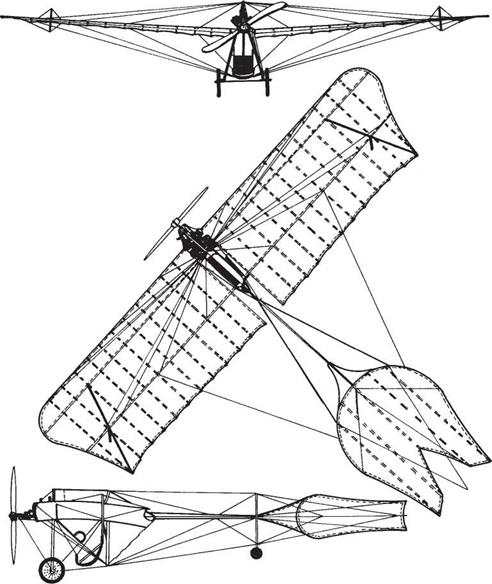
|
British-domiciled American Samuel Cody designed kites for the Royal Army. In 1907 he fitted a 12hp Bouchet engine to a kite of his own design which spanned 12m. Initial tests were unmanned, the kite being tethered in an intricate way. Analysing his experience, Cody improved the design with the result that the Army Balloon Factory began building an aeroplane with a military purpose in 1907. The Wrights’ Flyers acted as patterns, as is obvious from a glance at the machine. The Cody 1 was a biplane with two pusher propellers and a forward mounted elevator. It had a wheeled undercarriage and an aft mounted fin. Roll control was by wing twisting. The bamboo structure was cloth-covered.
Several attempts to get off the ground were made in September. Despite the lack of success, trials continued, Cody managing a 50m hop. His biggest success was on 16 October, when he flew 450m at a speed of 45km/h. Sadly, the return to earth was a crash landing. The craft was repaired and improved. In May 1909 Cody flew a mile in
|
I Cody’s Army Aeroplane being towed in September 1908 |
|
Cody’s biplane as modified with elevators |
|
|
|

it; in July, he covered almost six miles; and in September he achieved a record 39 miles. Despite being a foreign subject, Cody was recognised by the Royal Aeronautical Society as the first man to fly successfully in Britain.
Meanwhile, the British War Office was funding another aeroplane which looked strange even by the standards of today when practically anything has been tried. It was a flying-wing biplane. Stability was granted by the wings’ shape. It spanned 12m and was swept back 30 degrees. Lt John Dunn, who led the project at the Balloon Factory, chose a 12hp Bouchet engine driving a two blade pusher propeller. No structure testing methods were available at the time, nor were there yet any means of calculating stresses. The Dunn 1 fell apart during its first takeoff run. The military lost
|
Lieutenant Dunn’s ‘flying wing after a successful flight |
|
Lieutenant Dunn’s ‘flying wing after a successful flight |
interest in the project, but the Lieutenant continued developing it, increasing engine power, improving controls and structural stiffness, and ultimately coming up with the Dunn D.5 in 1910: the first successful flying wing.
The Wrights were not America’s only aeroplane makers. As early as late 1900, an exceptionally far-sighted and inventive man by the name of Glenn Hammond Curtiss founded an aeroplane company. The company’s first design was the Golden Flyer. This was similar to the Silver Dart which Canadian Mark Curdey was to fit with a Curtiss engine in 1908. The difference was in its lighter structure and the 50hp produced by the Curtiss V8 engine. Between June and September 1908 the
|
|
THE DUNN 8 (1912)
|
I Glenn Hammond Curtiss |
aeroplane made 54 flights. Since the Wrights had not registered their achievements officially before the end of that year, Curtiss was declared the first Amreican to cover a kilometre, and the first to fly a circling flight. In 1909, the same craft flew at the international air show near Rheims, reaching a speed of 70km/h and winning a prize for this speed. Over the next few years, Curtiss was to design a number of excellent aeroplanes which exported widely.
Russians were also trying to keep in step with developments. For a long time, efforts to design heavier-than-air machines were dogged by failure. It was only in May
|
I Curtiss’s John Bag in flight, 1908 |
|
I Curtiss’s Golden Flyer biplane in front of the Curtiss Company’s hangar at the 1909 Rheims Air Show |
1910 that Kiev Polytechnical Institute lecturer Aleksandr Sergeevich Kudashyov su- ceeded in building an aeroplane. The design was a canard triplane with a length of 10m, and a span of 9m. The craft was fitted with an 35hp Anzani engine. The designer had flown near Nice in the company of famous Russian pilot Efimov and felt competent to test-fly his creation. On 23 May 1910 he managed to make a few hops at a height of two to three metres. The event was not officially registered since the appropriate institutions had not been invited to witness it.
A month later, electrical engineer Yakov Modestovich Galkkel’ completed a most original aeroplane. The Gakkel’ 3 was the world’s first biplane with an inverted section wing: the leading and trailing edges were turned upward rather than down. The aeroplane had a tailplane, elevator and rudder. The engine, a 35hp Anzani, drove a two-bladed forward propeller. Structure was cloth-covered timber, weighing 560kg.
|
THE GOLDEN FLYER |
|
THE GAKKEL-3 |
On 6 June 1910 an All-Russian Aeroclub committee recorded the first flight of a Russian designed aeroplane. However, poor engine performance resulted in disappointing performance. The problem was later solved and Gakkel’s biplanes and his monoplane were to be equal to any.
Despite Hans Grade’s flight, German political and military leaders were becoming concerned at otherwise falling behind in aviation. To make up for this, in 1910 they bought the licence for the Austro-Hungarian Taube monoplane. That aeroplane’s story was rather interesting. The wing’s profile and planform were a replica of the winged seed of the tropical Zanonia plant. German scientist D. Alborn was impressed by this seed’s flat glide and surmised that it might serve as model for a flying machine.
|
I A Taube’s unfaired structure |
|
I A sports Etrich Taube with an Austro-Daimler 100hp engine |
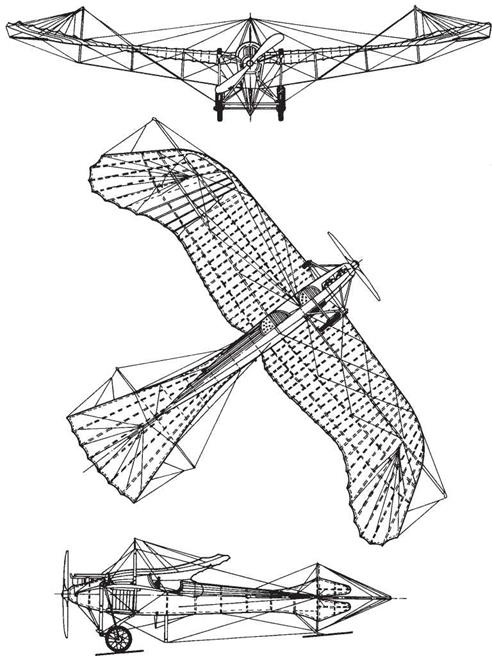
|
——————————————- >—————————————————–
The idea was developed by industrialist Hugo Etrich and engineer Franz Wells in the form of a glider rather similar to the natural original. The designers performed several flights in it in 1906, rearing distances of over 200m.
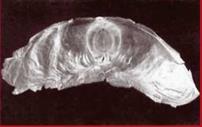 After the Zanonia flying wing was fitted with a 24hp Antoinette engine driving a two-bladed propeller, and with a twin-wheel undercarriage, it was tested again. Fears that the lack of an empennage would damage controllability were confirmed. An empennage was successfully designed and fitted later the same year, giving birth to the famous ■ The flying seed of the Zanonia plant Taube: most widely used German and Aus – which impressed Alborn trian aeroplane in the 1910 to 1915 period,
After the Zanonia flying wing was fitted with a 24hp Antoinette engine driving a two-bladed propeller, and with a twin-wheel undercarriage, it was tested again. Fears that the lack of an empennage would damage controllability were confirmed. An empennage was successfully designed and fitted later the same year, giving birth to the famous ■ The flying seed of the Zanonia plant Taube: most widely used German and Aus – which impressed Alborn trian aeroplane in the 1910 to 1915 period,
|
|
|
|
The Zanonia-derived Antoinette-engined flying wing monoplane |
and the first enemy aeroplane to fly over Paris after the outbreak of the First World War.
Aeroplane production was now picking up. The tense international situation made the military look more closely at the new-fangled, rather unreliable, kite-like flying machines. The main quality measure of the emerging component of the new measure of each nation’s potential was what records had been set and what achievements notched up. Bleriot was again among the leaders. In January 1909 he finished work on the Bleriot XI: the design that would bring him worldwide fame. On 25 July the same year, he flew it over the Channel. This was a leap forward in aviation development, which showed its great potential for the future.
The Bleriot XI was a high wing monoplane with a space-frame fuselage whose forward portion (housing the cabin and engine) were cloth-faired. Instead of ailerons, roll was controlled by wing warping. This was controlled by the same lever which moved the conventionally sited elevator. The rudder was pedal-controlled. This is how today’s aeroplane controls work!
Major structural material was chestnut. The wing was cloth-faired on both surfaces. The aeroplane was 8m long, had a span of 7.8m, and weighed 300kg. Maximum recorded speed was some 60km/h.
In My 1909, before his historic flight, Bleriot had modified the design. Instead of the capricious 30hp R. E.P engines, he fitted an Anzani motorcycle unit and married it to a new, more efficient prop, and a sealed fuel tank which gave buoyancy in case of a forced landing on water.
The aeroplane’s excellence apart, luck was also on Bleriot’s side. The most critical moment came when the engine overheated above the blue expanse of the strait.
|
I The Bleriot XI at the 1909 Paris Automobile and Aeroplane Salon |
|
Louis Bleriot on arrival in England on 25 July 1909 after his historic Channel crossing |
The cliffs of England were clearly visible, but height was insufficient to allow a dead – stick landing. At that moment, Providence itself seemed to help, sending cooling rain down and speeding Bleriot on.
The Bleriot XI became as celebrated as Bleriot the aviator. The machine was built in some numbers and exported widely. Its appearance and configuration were to influence many other enthusiasts.
Without a doubt, the most successful Bleriot XI development was Edouard Nie – uport’s aeroplane. Externally, it was almost identical to its progenitor, but had a broader body. This made it more aerodynamic: both in itself, and because it now housed the engine, cabin, and fuel tank. Less drag meant more range, a 50hp engine propelling the machine for over 100km.
|
|
|
THE BLERIOT XI |
>
|
I The Nieuport monoplane designed in 1910 |
The Nieuport 4 was most popular, being licence-produced in Russia and Italy. The machine was very manoeuvrable, and it is probably no accident that Russian pilot Nesterov performed the world’s first aerial loop in a Nieuport 4. The type’s military career began as a reconnaissance platform, but more importantly the type went on to become the world’s first fighter.
The first great air race near Rheims caused a ripple of interest in aviation to circle the world. Held in late summer 1909, it was attended by leading aircraft and aeroengine makers. Demonstrations of 38 aeroplanes were scheduled, 23 of these actually managing to make it into the air. Only three of the demonstrations were by the Wright brothers, the show being dominated by the French: Voisin, Bleriot, Farman, and Le – vasseur.
Many nations sent observers, including military men intent on seeing things at first hand and gathering comparable information. The British Government was one of those which monitored the event, subsequently resolving to boost the design and production of British aeroplanes. The first step was to subdivide the War Office department responsible for aeronautics into two, to address lighter and heavier-than-air vessels. The Army Aeroplane Factory was founded in 1911, renamed the Royal Aeroplane Factory when the Royal Air Corps was established a year later. Private enterprise was invited to lead the process of setting aeronautical standards.
This is an example of how emergent air power was incorporated into national structures. Each nation followed its own road in the resolution of problems linked with its presence in the air, this being determined by what others were doing, as well as by affordability and the intellect of is political and military elites.
Aviation fora continued to serve as signposts of progress. Involvement in them by national institutions, i. e. the state, also grew. The process was possibly best exemplified by developments in Britain. In summer 1912, some 30 aeroplanes took part in an
|
|
|
THE NIEUPORT 4 |
|
|
|
|
|
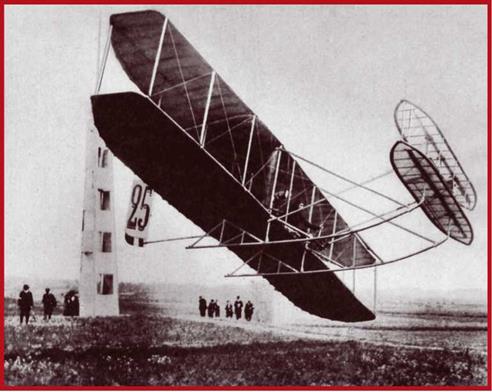
air show near Salisbury. The ulterior motive behind this must have been purely military: performance assessments included aeroplanes’ maximum level and landing speeds, rate of climb and other parameters important in a combat setting.
Undoubted winner of the show was the twin-seat BE2 biplane designed at Farn – borough. Designer Geoffrey de Havilland failed to win a personal award, yet in flying his machine, he reached a speed of 112km/h, a landing speed of 65km/h, a rate of climb of some 120m per minute, and a ceiling of almost 3500m. These indicators were achieved with a second man on board and a fuel load sufficient for a three-hour flight. Later de Havilland was to improve his design, retaining its speed and manoeuvrability, yet imparting phenomenal pitch and roll stability to it and sig-
|
THE B. E.2A (1913) |
nificantly easing controllability. Over the next few years the Royal Air Corps was to take delivery of over 2000 of this exceptionally simple and rational aeroplane.
As distinct from their march in France, monoplanes failed to impress the British. The findings after a series of crashes in summer 1912 (which cost the lives of two pilots) were that this layout was insufficiently strong. This was to leave a strong imprint on British aircraft manufacture. Notwithstanding the attainment of the amazing (for its time) speed of 200km/h by a Deperdussin at the 1913 Rheims air show, the British put their bets on biplanes with forward propellers.
An early exponent of this layout was the Bristol B. S.1 Scout. Designed by de Havil – land, it was compace and weighed 280kg. The powerful 80hp Gnome engine permit-
|
THE BRISTOL TABLOID (1913) |
ted a speed of 150km/h. The machine had a conventional elevator and rudder. Roll control was by wing warping, later replaced by ailerons. The aeroplane was intended to be a racer, but its high speed and good manoeuvrability recommended it to the military, and it was soon to equip the first high-speed reconnaissance units. After being fitted with a machine gun, the Scout was a reasonable fighter. Typical of British aeroplanes of the Great War, its configuration was repeated in the 1913 Avro 504, whose great conservatism did not stop it becoming one of the world’s most popular aeroplanes, being used in training establishments until the early 30s.
Armand Deperdussin’s 1913 racing monoplane was the undoubted peak of the French design school. A development of Bleriot and Nieuport’s ideas, everything in it
|
THE AVRO 504 (1913) |
was subjected to the reduction of drag and the attainment of the maximum possible speed. The fuselage was a monocoque, with load-bearing 4mm plywood skinning. Deperdussin faired-over and smoothed everything that could create drag. The machine was compact: 6.1m long, and spanning 6.6m, gross weight was 500kg. Engine was an air-cooled 14-cylinder two-row Gnome developing 160hp.
|
THE DEPERDUSSIN B (1911) |
|
I The World Speed Record Deperdussin racer |
The objective was reached. On 29 September, pilot Maurice Prevot covered a 200km distance in under an hour. The record was to stand for almost a decade, and remains one of the most outstanding ones. To contemporaries, the Deperdussin racer was not just an excellent flying machine, but also a fighter in sheep’s skin. However,
|
|
|
The Albatros B-l teas Germany’s standard intelligence gatherer after the outbreak of the First |
|
World War |
|
Reinhard Boehm with his Albatros after their record flight on 10 and 11 July 1914 |
both the British and French were to prefer biplanes for this role, and would pay heavily for this at the start of the Great War.
With the accumulated experience of Taube construction and operations, German designer Groman drew the twin-seat Albatros. The aeroplane lacked sparkling performance, yet had an irreplaceable quality preferred by pilots: great reliability. This was mostly attributable to its water-cooled 100hp Mercedes engine. Even though on the heavy side compared with French Gnomes and Rhones, this powerplant worked unfailingly and burned little fuel and oil. On 10 and 11 July 1914, pilot Reinhard Boehm flew an Albatros non-stop for 24 hours 12 minutes, beating all endurance records. The Albatros’s 100km/h maximum speed and its 300km combat radius made it one of the most successful aeroplanes of the First World War. During the conflict, the aeroplane was to be used mainly as a recce platform, and later as a pilot trainer.
Despite lagging behind, Russia left a lasting trace in pre-Great War aviation history. The major contributor to this was Igor’ Ivanovich Sikorskiy,[8] creator of the world’s first multi-engined aeroplane. The design of ‘a large aeroplane for strategic reconnaissance’ began in 1911. Construction at the Russo-Baltic Carriage Works in Riga took until early 1913. The result was a biplane with a 27m span and a wing area of 120sq m. Nothing else had anywhere near these dimensions. Powerplant installation was intersting. The four 100hp Argus engines were originally located in

|
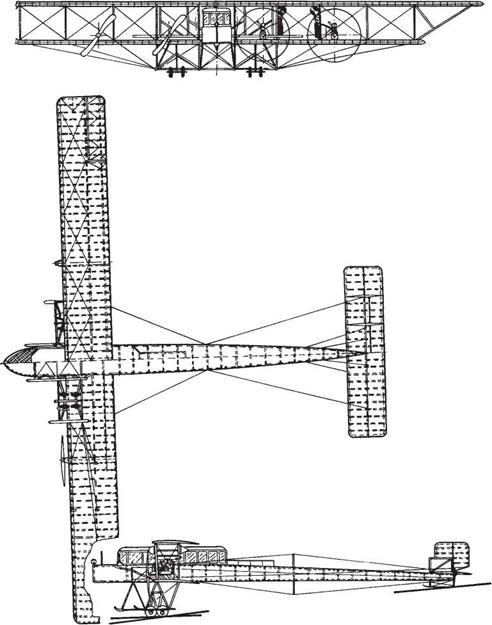
|
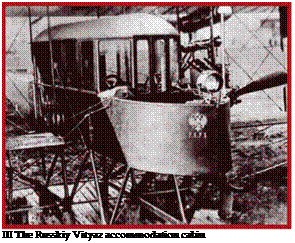 twin tandems, two per lower wng-mounted nacelle. Thus two propellers pulled, while the other two pushed. When it was found that the efficiency of the pusher props was rather low, all four engines were given individual nacelles on the lower wing.
twin tandems, two per lower wng-mounted nacelle. Thus two propellers pulled, while the other two pushed. When it was found that the efficiency of the pusher props was rather low, all four engines were given individual nacelles on the lower wing.
The fuselage was long and thin, its aft end supporting the tail. Forward was a large glazed cabin comprising a control compartment, two passenger cabin,
and compartments for tools and
spares. The nose was occupied by an open deck. Rather than being for promenading in flight, this was intended for night observation spotlights, or for machine guns. The giant was controlled by ailerons, rudder, and elevator. It had an eight-wheel undercarriage.
Few believed the aeroplane would fly. Some were of the opinion that it would be doomed if an engine failed in mid-air. Tests were to prove them entirely wrong. The Russkiy Vityaz[9] could return safely to base with just two working engines. Its maximum level speed was 90km/h. On 2 August the crew and seven passengers flew nonstop for two hours, recording a world record. The famous Il’ya Muromets[10] the world’s
|
I One of Sikorsky’s most famous project: the Il’ya Muromets strategic reconnaissance and bomber aircraft first flown in 1913 |
first strategic reconnaissance and bombing aeroplane, which was produced in some numbers, was a development of the Russian Knight.
The era when the first component of air power was created came to an end. A difficult start was followed by stormy advance. The total number of aeroplanes built during Europe’s five ultimate years of peace was significantly larger than anything seen before. But the ability to design aeroplanes capable of fulfilling set combat tasks was not sufficient to guarantee an aerial presence to the nations that could afford it. Additional requirements soon made themselves felt, all of them acquiring key importance in the emergence of air power.











